Writing Rests #8 – Sixty-Fourth Rest
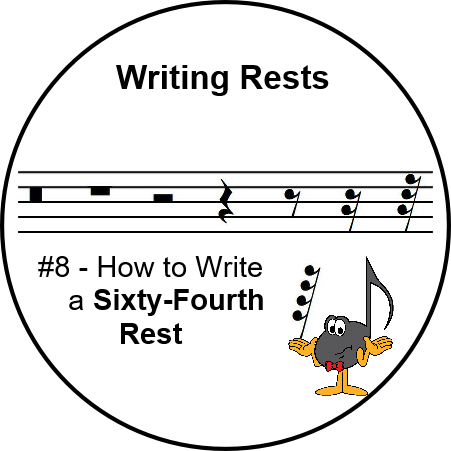
Welcome to the Ultimate Music Theory Blog Series on How to Write Rests.
- Writing Rests Blog Series #1 - How to Write a Breve Rest
- Writing Rests Blog Series #2 - How to Write a Whole Rest
- Writing Rests Blog Series #3 - How to Write a Half Rest
- Writing Rests Blog Series #4 - How to Write a Quarter Rest
- Writing Rests Blog Series #5 - How to Write an Eighth Rest
- Writing Rests Blog Series #6 - How to Write a Sixteenth Rest
- Writing Rests Blog Series #7 - How to Write a Thirty-Second Rest
In this BONUS eighth blog in this Writing Rests Blog Series, we explore How to Write a Sixty-Fourth Rest.
This Series explores how to write the rests properly by hand. It is not about when we write particular rests. If you have any concern, either as a Student or as a Teacher, about what rests should be used, Ultimate Music Theory has lots of ways to help:
- Teach Rhythm and Rests - This online course is perfect for giving you confidence as a Teacher. You will discover how to easily determine the division of rhythm & rests.
- Complete Music Theory Course - This online course is a great "refresher" course for Teachers and is perfect for Senior Students who wish to prepare for entrance to any Post-Secondary School for Music.
- Ultimate Music Theory Certification Course - Want to take your Teaching to the next level of Excellence? This online course will do that. Join the hundreds of UMTC Certified Teachers around the world who have expanded their Studios and their Teaching Confidence.
The Dolmetsch Online Music Dictionary says that a Sixty-Fourth Rest is to rest one sixty-fourth the time value of a whole rest.
Music Notes are Fractions: A Whole Note = 2 Half Notes = 4 Quarter Notes = 8 Eighth Notes = 16 Sixteenth Notes = 32 Thirty-Second Notes = 64 Sixty-Fourth Notes. (Wow, that is fast!)
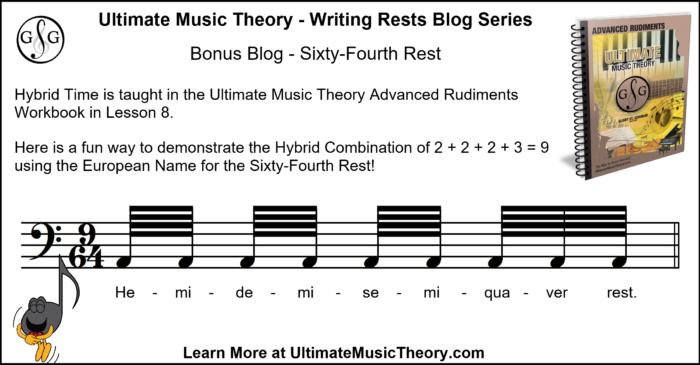
Writing Rests Blog #8 - Sixty-Fourth Rest
Rests are an important part of music. Rhythm uses notes and rests, sound and silence.
A Sixty-Fourth Rest is also called:
- a hemidemisemiquaver rest (in England)
- a pausa di semibiscroma (in Italian)
- a seizième de soupir (in French)
- a Vierundsechzigstelpause (in German)
- a silencio de semifusa (in Spanish)
When I introduce Hybrid Time, Lesson 8 in the Ultimate Music Theory Advanced Rudiments Workbook, I introduce the "hemidemisemiquaver rest" to my students. Oh my goodness, but we laugh so hard. You try saying that 4 times in a row in a Hybrid 2+2+2+3 rhythm!
Using silly sounding words is actually a super way to support Students learning different types of rhythms. I'd love to hear if you use something unique in your studio to help students feel the pulse of a Hybrid Time Signature.
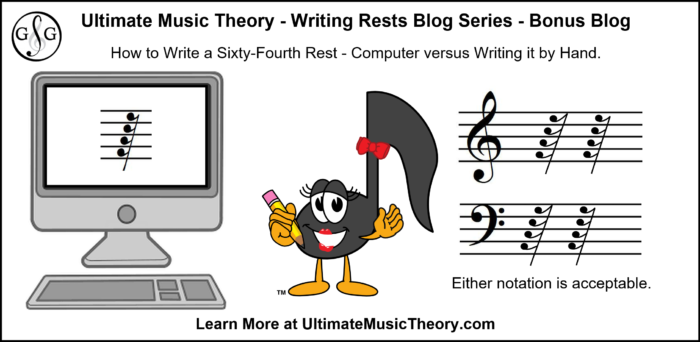
The Norton Manual of Music Notation states that "Rests should be drawn to resemble those found in engraved music as closely as possible".
Engraved Music today is typically music that is written using a Computer Program. It took me hours to write every single one of these Blog Rest examples "by hand" (using my computer mouse and the pencil app). So, although I could not actually write "by hand with a pencil" straight into this Computer Blog, I did every one of these "by hand" examples by hand with my pencil app thing-a-ma-bob. (Yup, I'm not exactly tech-savvy - LOL.)
How to Write a Sixty-Fourth Rest by Hand
A 64th Rest looks like a long Eighth Rest with 3 more hooks!
There are 2 different opinions on the correct way to write the 64th Rest.
- Drawing that upper line (the "hook") up to touch Staff Line #5.
- Drawing that upper line (the "hook") to end in the middle of Space #4.
Both ways are correct.
No matter where you like to end that upper hook, it cannot extend up above the Staff. The bottom of the Sixty-Fourth Rest must extend down below Staff Line #1. This is the only rest that is written (when in normal use) so that part of the Rest is outside of the Staff.
A good rule is to extend the angled line of the 64th Rest so that it ends where you would write the first ledger line below the Staff.
As the Examiner for the Ultimate Music Theory Certification Course, I see so many sloppy rests. Please practice how to draw these rests! If you cannot draw them properly, you will struggle to teach your Students how to draw them properly.
We should not be sloppy Teachers! Using your Ultimate Music Theory Whiteboard is a great way to practice writing (drawing) rests correctly.
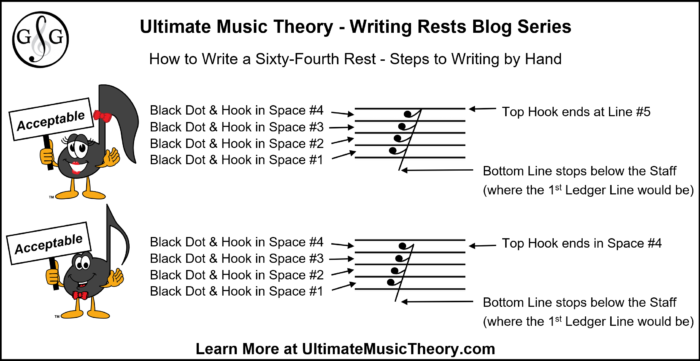
Writing Rests Blog Series 8 - Spot the Boo-Boos!
I love using my Whiteboard and showing my students 2 examples of a rest - one written correctly and one written incorrectly. We call the game "Spot the Boo-Boo". Once the Student spots the Boo-Boo, then they have to explain to me how to FIX the Boo-Boo!
I've written 3 Incorrect Sixty-Fourth Rests - can you spot the reason why they are incorrect?
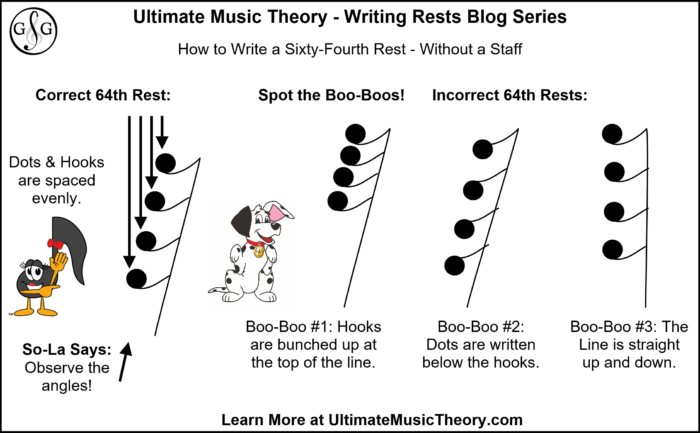
The Writing Rests Blog Series
This Blog Series will be focusing on how to write rests, and not on WHAT rest to write. Each Blog also has a matching Worksheet (with a corresponding Answer Sheet). To get these resources, join the Ultimate Music Theory Membership!
Thank you for reading! I look forward to seeing you in the SECOND BONUS Writing Rests Blog Series #9 - The Dotted Rest Blog.
And, if you missed it, please remember to check out:
- Writing Rests Blog #1 - Breve Rest
- Writing Rests Blog #2 - Whole Rest
- Writing Rests Blog #3 - Half Rest
- Writing Rests Blog #4 - Quarter Rest
- Writing Rests Blog #5 - Eighth Rest
- Writing Rests Blog #6 - Sixteenth Rest
- Writing Rests Blog #7 - Thirty-Second Rest
Ultimate Music Teachers Membership
♪ LEARN ♪ PLAN ♪ TEACH ♪ GROW
The One & ONLY Ultimate Music Teachers Membership
To Become A UMT PRO!
Your Success Path Starts Here - Go To TeachUMT.com Today!
Keep on Learning... With a Smile and a Song!
Shelagh McKibbon-U'Ren


